Day Four - Embodying, Living it Daily, Prototyping
Welcome and check-in
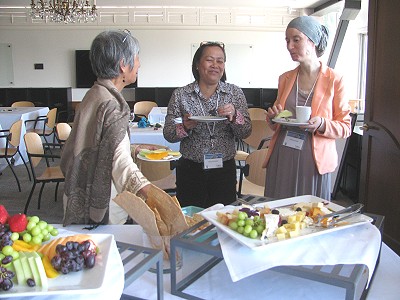 Warming up over coffee and the usual rich mix of croissants and other goodies for breakfast all participants gathered again in the open circle.
Warming up over coffee and the usual rich mix of croissants and other goodies for breakfast all participants gathered again in the open circle.
As a way to reconnect to one another after very different experiences the previous day, everybody was asked to share one image or object from the learning journey.
Having heard all voices, Ngaio explained the flow of the day.
Sharing stories from the journeys
The “video group” met some passionate people in the Museum of Anthropology, where Beau Dick, his apprentice, Cole Speck, and grandson, Ryan Speck, performed with masks embodying the rituals of life through the story of the lost child.
This is the story of a child mistreated by his father out of sorrow for loosing his beloved wife in childbirth. The boy has a miserable childhood and is considered a good for nothing by his grieving and bitter father. He is also not beautiful and uneasy with himself. One day, the boy gets lost in the forest, while leaving the bucket behind at the riverside with which he was supposed to fetch fresh water for his father. The villagers finding the bucket bring it back to the father, who was already getting furious because of the delay of bringing the water home. Now the father's fury turns into worry that his son might have drowned.
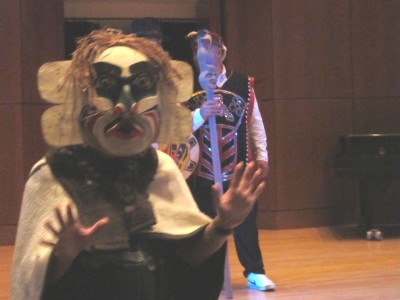 Meanwhile, the boy sets a snare as he is hungry, but falls asleep. Setting snares is the one skill he excells at. In his dream a bird trapped in his snare promises to take him to a good place where the spirits dance. When he wakes, a frees a grouse and meets the shy forest spirits. Each of them gives him a gift.
Meanwhile, the boy sets a snare as he is hungry, but falls asleep. Setting snares is the one skill he excells at. In his dream a bird trapped in his snare promises to take him to a good place where the spirits dance. When he wakes, a frees a grouse and meets the shy forest spirits. Each of them gives him a gift.
The forest spirits represent many characters: the Door to go through into new territory, the Ear to listen to others and deep inside, the sense of humour of men and that of women, and many more.
The characters are represented each one through a different mask. The masks are metaphores for the different values, character traits, skills and competencies needed in life, including those that are ambiguous or even contradictory in nature.
Thus equipped, the boy wakes up and returns to his village. He is reunited happily with his father, who is at long last grateful to have his son.
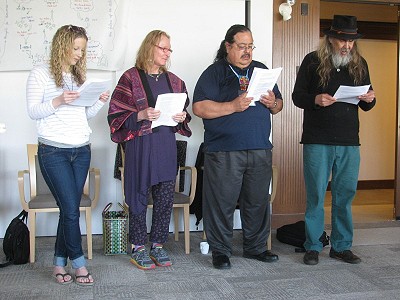 This formed part of the background that the group had explored through their visit in the Museum of Anthropology where several versions of some of the masks are on display.
This formed part of the background that the group had explored through their visit in the Museum of Anthropology where several versions of some of the masks are on display.
The group also viewed and shared in plenary a speech that Beau Dick had delivered in Victoria on the steps of the Legislature at a traditional Copper breaking ceremony in protest of how the government has treated the First Nations people in Canada and the country's environment.
Francisco took this speech, transcribed and then edited it into a poem.
The group performed that poem as part of their "debriefing".
The poem also provided the framing for the video that the group registered on their learning journey in addition to excerpts from a discussion Cole Speck, Beau's apprentice, and the 'passionate young person' that the group went to speak with that day. Meanwhile, the video has been finalised.
Click here to watch it: "We are all connected!".
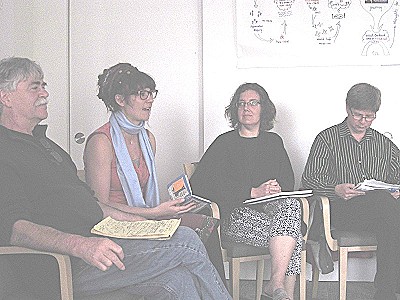 The second group in search of passionate people left campus and explored East Vancouver, the original centre of town a century ago, and now a neighbourhood with many economically poor people. The group found a disconnect between people and nature and food. They attribute that to prevailing policies overlooking environmental problems in favour of attempts to restart the local economy.
The second group in search of passionate people left campus and explored East Vancouver, the original centre of town a century ago, and now a neighbourhood with many economically poor people. The group found a disconnect between people and nature and food. They attribute that to prevailing policies overlooking environmental problems in favour of attempts to restart the local economy.
Galery Gachet has a mandate to empower poor people through art and human-driven approaches as compared to techno-fixes.
The group found seeds of hope and saw how the Galery was providing a space for self healing and innovation, an active practice of solidarity and community.
The group visited another studio, this time of a graphic facilitatory who is working with small groups supporting conversations about possible transformations and expressing these visually.
In Point Grey, the group visited Sole Food Street Farm which creates employment, reintroduces people to farming and offers school programmes, e.g. with 'planting boxes'. The chef of the Four Seasons hotel is making a point to make people appreciate where the fish and the food served is coming from.
In summary the group had discovered communities poor in $, but rich in human relations and full of innovative ideas. Everybody was talking in small-scale terms, but possibilities for replication and scaling up could be identified (though not without problems).
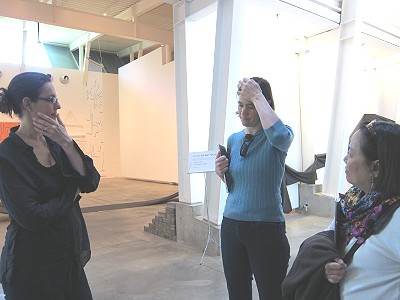 The 'exhibition group' came back from its learning journey with confirmation that the ocean was considered a strong and attractive theme for a mobile exhibition.
The 'exhibition group' came back from its learning journey with confirmation that the ocean was considered a strong and attractive theme for a mobile exhibition.
Setting out in the Morris and Helen Belkin Art Gallery just opposite the roundtable venue, Shelly Rosenblum, Curator Academic Collections, showed the group around the showrooms and other facilities.
A chance meeting with the archivist splitting her time between the Belkin Art Gallery and other institutions led to suggestions of a few avenues towards potentially interested groups.
The conversation focused quickly on testing exhibition concepts on a smaller scale accompanied by research into visitor reactions and engagement. It would certainly be wise to develop prototypes and test the concepts step by step to manage the risks and make the exhibition credible for potential host institutions, such as aquaria and museum.
An experimental workshop with curators, scientists, artists and people from computer animation labs would be a useful stepping stone.
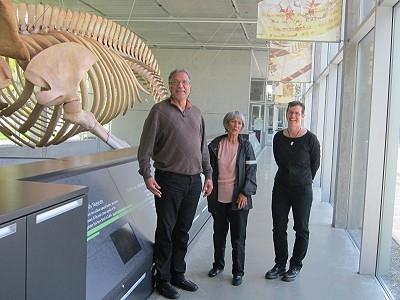 Sally Otto, Fellow Royal Society of Canada, Director of Biodiversity Research Centre, at the Beaty Museum of Biodiversity, walked the group around the spectacular skeleton of a stranded Blue Whale and the extensive underground collections open to visitors.
Sally Otto, Fellow Royal Society of Canada, Director of Biodiversity Research Centre, at the Beaty Museum of Biodiversity, walked the group around the spectacular skeleton of a stranded Blue Whale and the extensive underground collections open to visitors.
The museum encourages visitors to explore more artefacts in drawers and has a much-visited childrens' corner.
The afternoon trip to meet Andrea Durham, Vice-President, Exhibits, Facilities, and Digital Initiatives at Science World, was particularly productive in terms of some dos and don'ts borne out of the institution's own practice and Andrea's long-standing professional experience.The team was very grateful that Andrea was willing to give up twice as much time out of her busy schedule than originally planned.
A visit to Eric Solomon, Director of Arctic Programs in the Vancouver Aquarium, was scheduled for Friday afternoon, after the official end of the Roundtable and also turned out to be both pleasant and highly useful. And, of course, the visit in the splendid aquarium itself the following day was a great experience and warrants repeat visits to appreciate the different sections more fully.
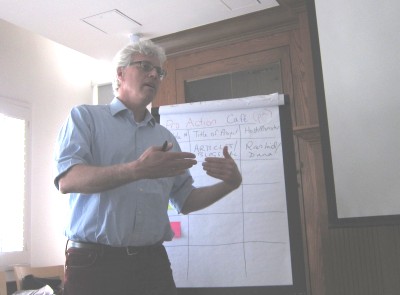 Naomi reported vividly about very productive conversation with the musicians of a parallel Roundtable exploring the use of music for therapeutical purposes.
Naomi reported vividly about very productive conversation with the musicians of a parallel Roundtable exploring the use of music for therapeutical purposes.
Last but not least, Paolo introduced the key concepts underlying the potential of introducing a local currency as a means to rediversify the financial system for greater sustainability and for giving local actors e.g. in the fishing industry and connected businesses a new lease of life.
A wide variety of experiences exists with alternative exchange mechanisms and currencies. One of the biggest in size was a government-backed scheme during the Argentinean financial crisis in the early 2000s, but others existed or exist in Switzerland and many other places. A growing number of economists believes that alternatives to the prevailing monoculture are essential to stabilise the global system that some people fear might collapse with unpredictable consequences. Paolo will, as a result of his learning journey and earlier work on the theme pay a visit to Sardegna in the summer to collect some empirical evidence about this particular experiment that has been running for the last few years.
Open Space Technology – Pro Action Café
 Ngaio and Cornelia then introduced the notion of the open space technology or a market of ideas. Whoever wants to develop a project that had either come out of the learning journeys or that had been a concern of a participant and could be suggested for a conversation, to develop it a step further by taking advantage of the different experiences and vantage points of other Roundtable participants. The proposer comes forward and formulates a question or challenge, which he or she writes down on a 'bill board' matrix with the numbers of tables available. The project promoter makes a short marketing pitch to attract others to his or her table.
Ngaio and Cornelia then introduced the notion of the open space technology or a market of ideas. Whoever wants to develop a project that had either come out of the learning journeys or that had been a concern of a participant and could be suggested for a conversation, to develop it a step further by taking advantage of the different experiences and vantage points of other Roundtable participants. The proposer comes forward and formulates a question or challenge, which he or she writes down on a 'bill board' matrix with the numbers of tables available. The project promoter makes a short marketing pitch to attract others to his or her table.
The working mode is similar to the World Café. The promoter remains at the table as host and keeps a record of the conversation, while other participants come and go for two rounds contributing to the reflection of the question behind the question in the first round and finding out what may still be missing in the second round. The principal difference is that before entering in the third round of conversations, the table hosts / project promoters get a few minutes to distill the next elegant steps for implementing their project. During the third round the same people of the second help to refine that action plan (thu s, there is no additional rotation).
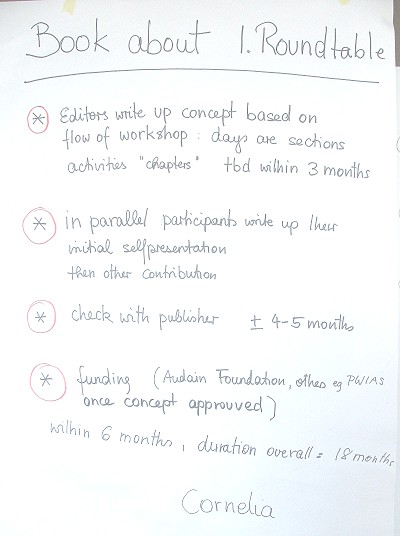 Altogether seven project proposals were discussed:
Altogether seven project proposals were discussed:
- How to model Spaceship Earth? - Alan Mackworth
-
Can we expand the conversation to include eco-theolo gy and build on the aboriginal spirituality introduced by Beau Dick and Francisco Alarcón? - Nigel Haggan
-
What do we need to do to produce a contrasted global video interview about the ocean? - Dyhia Belhabib
-
Can we capture our experience in a book? - Cornelia Nauen
-
What other written output can we produce? - Rashid Sumaila
-
What does it take to bring “FishCoin” on its way? - Paolo Dini
-
A facebook page for Spaceship Earth? - Francisco Alarcón and Sarah Meltzoff.
Promoters were requested to write down the key points of their action plan on a poster to harvest the results in plenary.
As a result of the conversation, the “FishCoin” project was renamed “Fish-Credits” and part of the original ideas for a facebook page will be shifted to the PWIAS and Mundus maris websites
With so many concrete projects and ideas in the room, the wrap up was helped by the visual summaries and a short closing comment by each participants.








